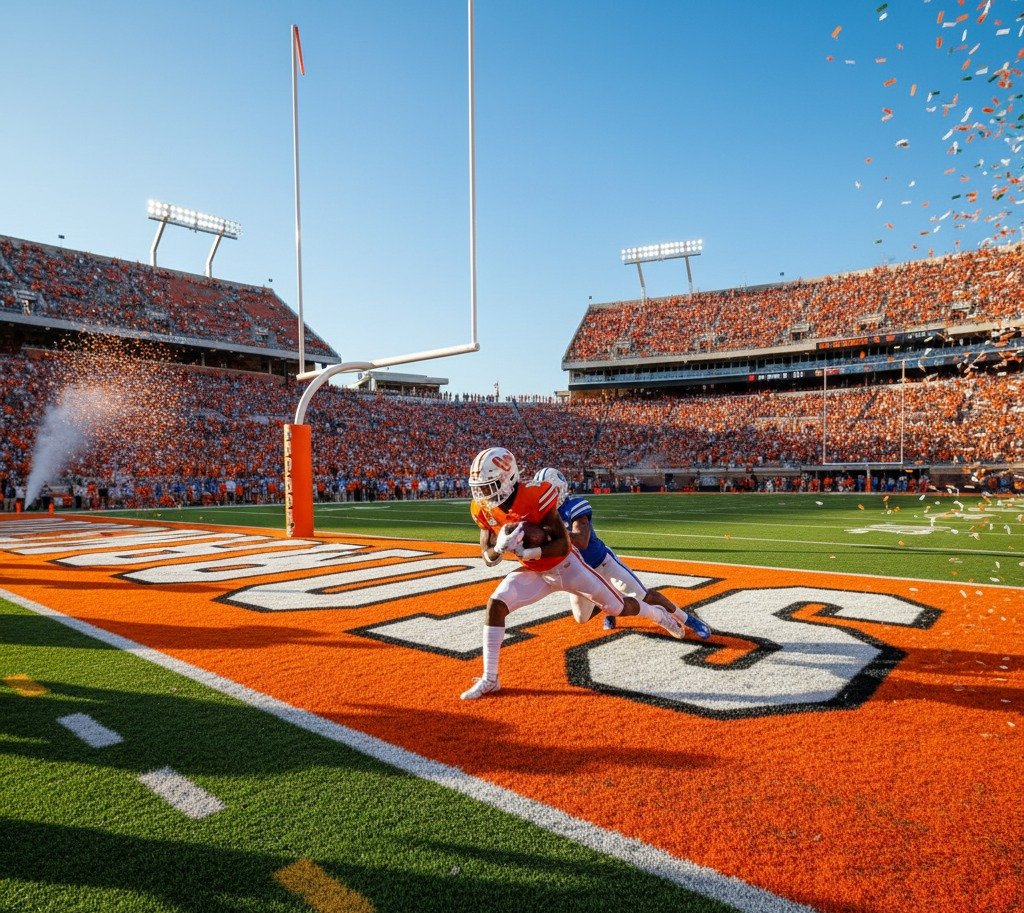When people first start watching American football, one of the first questions they often ask is: “How deep is a football end zone?” Whether you’re watching the NFL, college football, or high school football, the answer is the same:
A football end zone is 10 yards deep.
That means each end zone extends 10 yards past the goal line, making the entire football field 120 yards long when you include both end zones.
But the end zone is more than just an area on the field—it’s the ultimate scoring destination and one of the most exciting places in all of sports. In this article, we’ll break down everything you need to know about football end zones, from their exact dimensions to their history, design, and role in scoring plays.
What Is an End Zone in Football?
The end zone is the rectangular scoring area located at both ends of the football field. To score a touchdown, the ball must cross the goal line and enter the end zone, either by being carried, caught, or recovered there.
Every field has two end zones:
One that the home team defends and the away team attacks.
One that the away team defends and the home team attacks.
Without the end zone, there would be no touchdowns, no spectacular catches, and no game-winning moments.
Official Dimensions of a Football End Zone
So, how deep is a football end zone exactly? Let’s get specific.
Depth (front to back): 10 yards (30 feet)
Width (sideline to sideline): 53 ⅓ yards (160 feet), the same as the width of the field
Area: 5,300 square feet per end zone
With two end zones, the combined scoring areas equal 10,600 square feet.
This setup is consistent across:
NFL (National Football League)
NCAA (college football)
High school football
How the End Zone Fits Into the Football Field
A standard American football field has two key parts:
The main playing field, which is 100 yards long.
Two end zones, each 10 yards deep, one on each end.
That means the total field length is 120 yards from end line to end line.
Width of the field: 53 ⅓ yards (160 feet)
Total area (including end zones): about 57,600 square feet
This consistency ensures fairness and uniformity across every level of organized football.
Why Are Football End Zones 10 Yards Deep?
You may wonder: why not 5 yards? Or 15? Why did the rules settle on 10 yards?
Here are the main reasons:
Balance Between Offense and Defense
– A 10-yard depth is just enough space to allow passing and running plays near the goal line without making it too easy to score.Historical Consistency
– Since the early 20th century, when football’s rules were standardized, the 10-yard end zone has been used. Keeping it consistent allows fields to be interchangeable.Strategic Variety
– The depth allows teams to run short-yardage rushing plays, fade routes, slants, and even trick plays near the goal line.Safety Considerations
– A 10-yard buffer behind the goal line prevents collisions from happening too close to barriers or stands.
Markings and Design of the End Zone
End zones are more than just empty rectangles; they’re carefully marked and often decorated.
Goal Line: The line that separates the playing field from the end zone. The football only needs to break the plane of this line to score a touchdown.
End Line: The boundary at the very back of the end zone. If a ball carrier steps past this line, the play is dead.
Sidelines: The left and right boundaries of the end zone.
Decorations: Many stadiums paint their end zones with team colors, logos, or names to showcase team pride.
In the NFL and NCAA, end zones are often works of art—striped, lettered, and customized for each team. In high school football, they may be plain with only boundary lines.
How Scoring Works in the End Zone
Because the end zone is 10 yards deep, it plays a critical role in every scoring situation:
Touchdown (6 points): When a player carries or catches the ball in the end zone.
Two-Point Conversion (2 points): Attempted from near the end zone after a touchdown.
Extra Point Kick (1 point): Kicked through the uprights located at the back of the end zone.
Field Goal (3 points): Also kicked through the goalposts behind the end zone.
Safety (2 points): If the offensive team is tackled in their own end zone.
Fun Facts About Football End Zones
The Canadian Football League (CFL) uses 20-yard deep end zones, which creates more open space for passing plays.
End zone celebrations (like the Lambeau Leap in Green Bay) have become a cultural part of football.
In earlier versions of football in the late 1800s, there were no end zones at all—the goal line itself determined scoring.
With end zones included, a football field is 20% longer than just the 100-yard playing surface.
Common Questions About End Zones
1. How big is a football end zone in feet?
It is 30 feet deep (10 yards) and 160 feet wide.
2. Are all football end zones the same size?
Yes, in American football, all organized levels (NFL, NCAA, high school) use 10-yard deep end zones.
3. Why are Canadian end zones bigger?
The CFL wanted a more open, offensive game, so their end zones are 20 yards deep.
4. Does the goalpost sit inside the end zone?
In the NFL and NCAA, the goalpost is located at the back of the end zone on the end line. In earlier history, they used to sit on the goal line.
Conclusion
So, how deep is a football end zone? The answer is clear: 10 yards deep, across all levels of American football. Together, the two end zones add 20 yards to the field, making the total length 120 yards.
The end zone may just be 10 yards in size, but it’s the most exciting place on the field. It’s where touchdowns happen, where championships are decided, and where fans celebrate the biggest moments in football.

